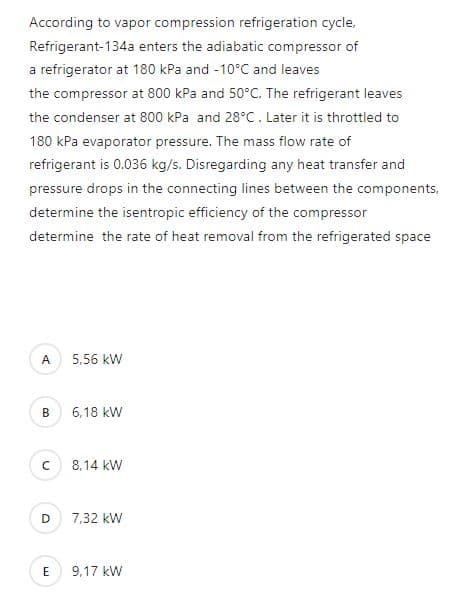According to vapor compression refrigeration cycle, Refrigerant-134a enters the adiabatic compressor of a refrigerator at 180 kPa and -10°C and leaves the compressor at 800 kPa and 50°C. The refrigerant leaves the condenser at 800 kPa and 28°C. Later it is throttled to 180 kPa evaporator pressure. The mass flow rate of refrigerant is 0.036 kg/s. Disregarding any heat transfer and pressure drops in the connecting lines between the components, determine the isentropic efficiency of the compressor determine the rate of heat removal from the refrigerated space
According to vapor compression refrigeration cycle, Refrigerant-134a enters the adiabatic compressor of a refrigerator at 180 kPa and -10°C and leaves the compressor at 800 kPa and 50°C. The refrigerant leaves the condenser at 800 kPa and 28°C. Later it is throttled to 180 kPa evaporator pressure. The mass flow rate of refrigerant is 0.036 kg/s. Disregarding any heat transfer and pressure drops in the connecting lines between the components, determine the isentropic efficiency of the compressor determine the rate of heat removal from the refrigerated space
Refrigeration and Air Conditioning Technology (MindTap Course List)
8th Edition
ISBN:9781305578296
Author:John Tomczyk, Eugene Silberstein, Bill Whitman, Bill Johnson
Publisher:John Tomczyk, Eugene Silberstein, Bill Whitman, Bill Johnson
Chapter28: Special Refrigeration Applications
Section: Chapter Questions
Problem 15RQ: Why is two-stage compression popular for extra-low-temperature refrigeration systems?
Related questions
Question
no chatgpt no plaigiarism

Transcribed Image Text:According to vapor compression refrigeration cycle,
Refrigerant-134a enters the adiabatic compressor of
a refrigerator at 180 kPa and -10°C and leaves
the compressor at 800 kPa and 50°C. The refrigerant leaves
the condenser at 800 kPa and 28°C. Later it is throttled to
180 kPa evaporator pressure. The mass flow rate of
refrigerant is 0.036 kg/s. Disregarding any heat transfer and
pressure drops in the connecting lines between the components,
determine the isentropic efficiency of the compressor
determine the rate of heat removal from the refrigerated space
A
B
с
D
E
5,56 kW
6,18 kW
8,14 kW
7,32 kW
9,17 kW
Expert Solution
This question has been solved!
Explore an expertly crafted, step-by-step solution for a thorough understanding of key concepts.
Step by step
Solved in 6 steps with 9 images

Knowledge Booster
Learn more about
Need a deep-dive on the concept behind this application? Look no further. Learn more about this topic, mechanical-engineering and related others by exploring similar questions and additional content below.Recommended textbooks for you

Refrigeration and Air Conditioning Technology (Mi…
Mechanical Engineering
ISBN:
9781305578296
Author:
John Tomczyk, Eugene Silberstein, Bill Whitman, Bill Johnson
Publisher:
Cengage Learning

Refrigeration and Air Conditioning Technology (Mi…
Mechanical Engineering
ISBN:
9781305578296
Author:
John Tomczyk, Eugene Silberstein, Bill Whitman, Bill Johnson
Publisher:
Cengage Learning